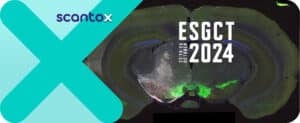Reliable in vitro models are essential for studying the pathophysiology of Gaucher disease (GD) and developing therapeutic strategies. The pathological accumulation of lipids due to deficiencies in specific lysosomal enzymes as characteristic for GD can be evaluated in human fibroblasts (HF) derived from GD patients and mouse embryonic fibroblasts (MEF) of the GD mouse model 4L/PS-NA.
These in vitro models are well-suited for early-stage screening, compound profiling, and mechanistic studies. To support lead optimization and preclinical validation, in vitro insights can be transferred into the also offered corresponding in vivo 4L/PS-NA mouse model, enabling the assessment of therapeutic effects through established readouts such as biomarker levels, histopathology, and tissue lipid accumulation.
Glucocerebrosidase (GCase) activity of all human and mouse fibroblast lines is significantly reduced compared to healthy human fibroblasts (Figure 1A). GD-associated substrate levels are highest in type 1 human fibroblasts derived from GD patients (Figure 1B-D), but conduritol β epoxide (CBE)-treated healthy human fibroblasts and MEFs of 4L/PS-NA mice also present significantly increased levels of selected substrates (Figure 1B-D).

Figure 1. Significantly reduced GCase activity and increased substrate accumulation in different GD patient-derived fibroblasts, healthy control cells treated with CBE as well as mouse embryonic fibroblasts (MEFs) from 4L/PS-NA mice. A: GCase activity in healthy control human fibroblasts (HF) ± CBE, GD patient-derived fibroblasts as well as 4L/PS-NA MEFs, assessed with 4-MUG-based activity assay. B-D: GD-associated substrate levels assessed with HPLC-MS/MS in cell pellets from the above-described cell lines. Highest level of accumulated substrates in GD Type I cells. Data are shown as relative fluorescent unit (RFU; A) or pg lipid per µg protein. Mean + SEM (n=6 replicates per group). One-way ANOVA followed by Bonferroni post hoc test: *p<0.05; **p<0.01, ***p<0.001.
Staining of human and mouse fibroblast lines with LysoTracker™ to visualize lysosomes shows a significantly stronger staining in Type 1 human fibroblasts derived from GD patients (Figure 2B, E) and MEFs of 4L/PS-NA mice (Figure 2D, E) compared to healthy human fibroblasts.

Figure 2. Representative images of lysosome staining using LysoTracker™ as well as evaluation of the respective signal in fibroblast cell lines from different GD patients, 4L/PS-NA MEFs and healthy control cells. A-D: Enlarged and intensely stained lysosomes in GD and MEF-4L/PS-NA cell lines compared to the healthy control. Most intense staining in GD Type 1 cells (B, scale bar 400 µM). E: Data are shown as Integrated Intensity Object Average / Phase Area Confluence normalized to healthy control of LysoTracker™ images. Mean + SEM (n=6 replicates per group). One-way ANOVA followed by Bonferroni post hoc test ***p<0.001.
These results support the utility of fibroblast-based models while emphasizing the translatability of in vitro models and highlighting the potential for refinement with in vivo models for a comprehensive understanding of Gaucher disease pathophysiology.
Next to fibroblasts of 4L/PS-NA mice, also MEFs of Gaucher disease mouse models with various GBA mutations, such as GBA D409V, or other lysosomal storage diseases, such as Niemann-Pick disease or Pompe disease, can be used.
Human fibroblasts derived from GD patients and MEFs from 4L/PS-NA mice are thus a valuable model for in vitro Gaucher disease research and allow a seamless transition from in vitro to in vivo studies.
Contact us today to get your in vitro study in fibroblasts started!









